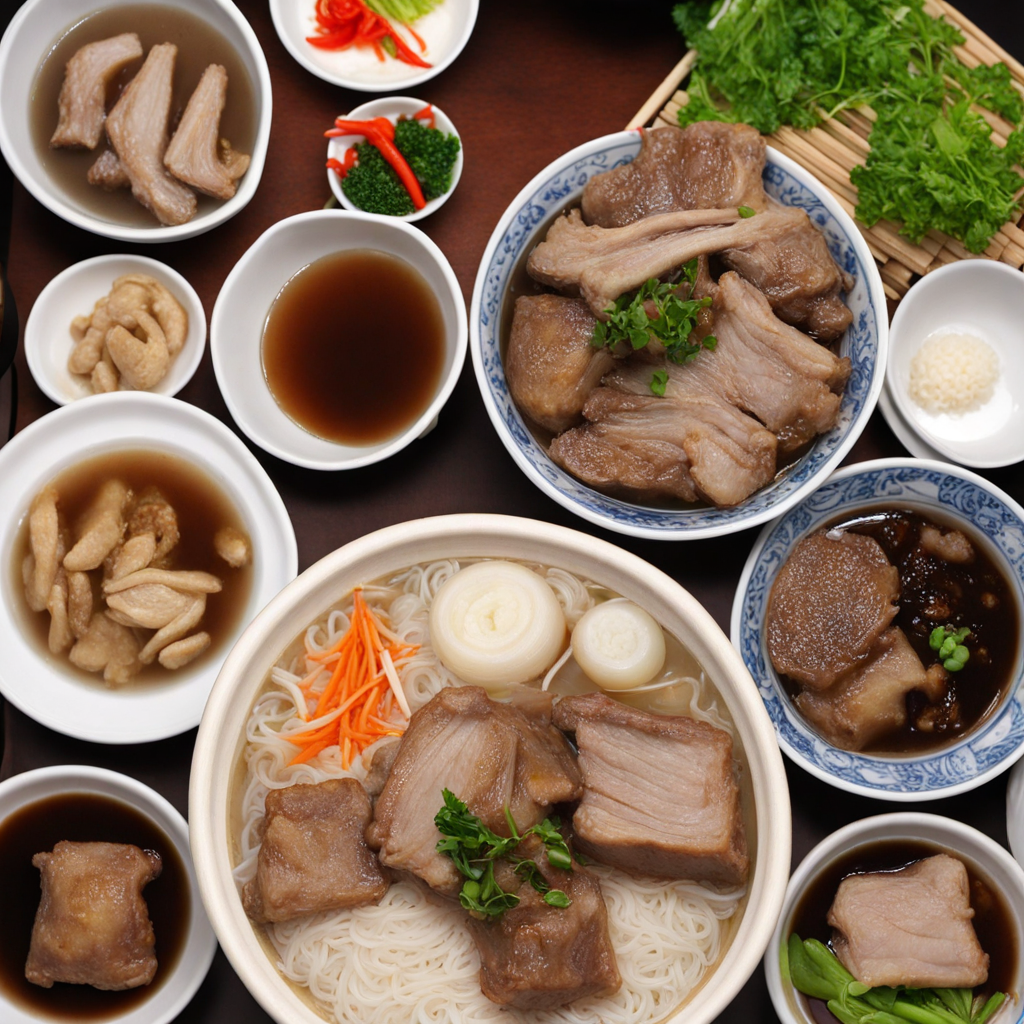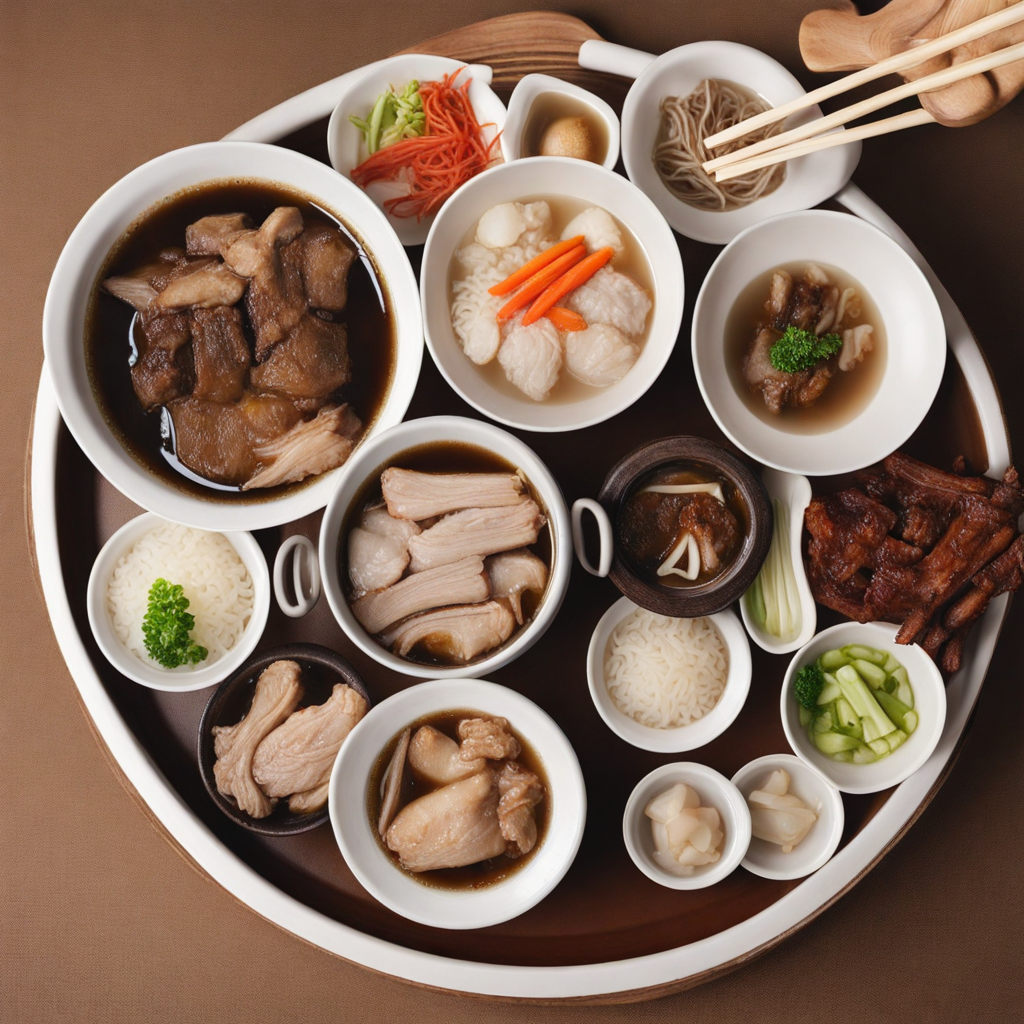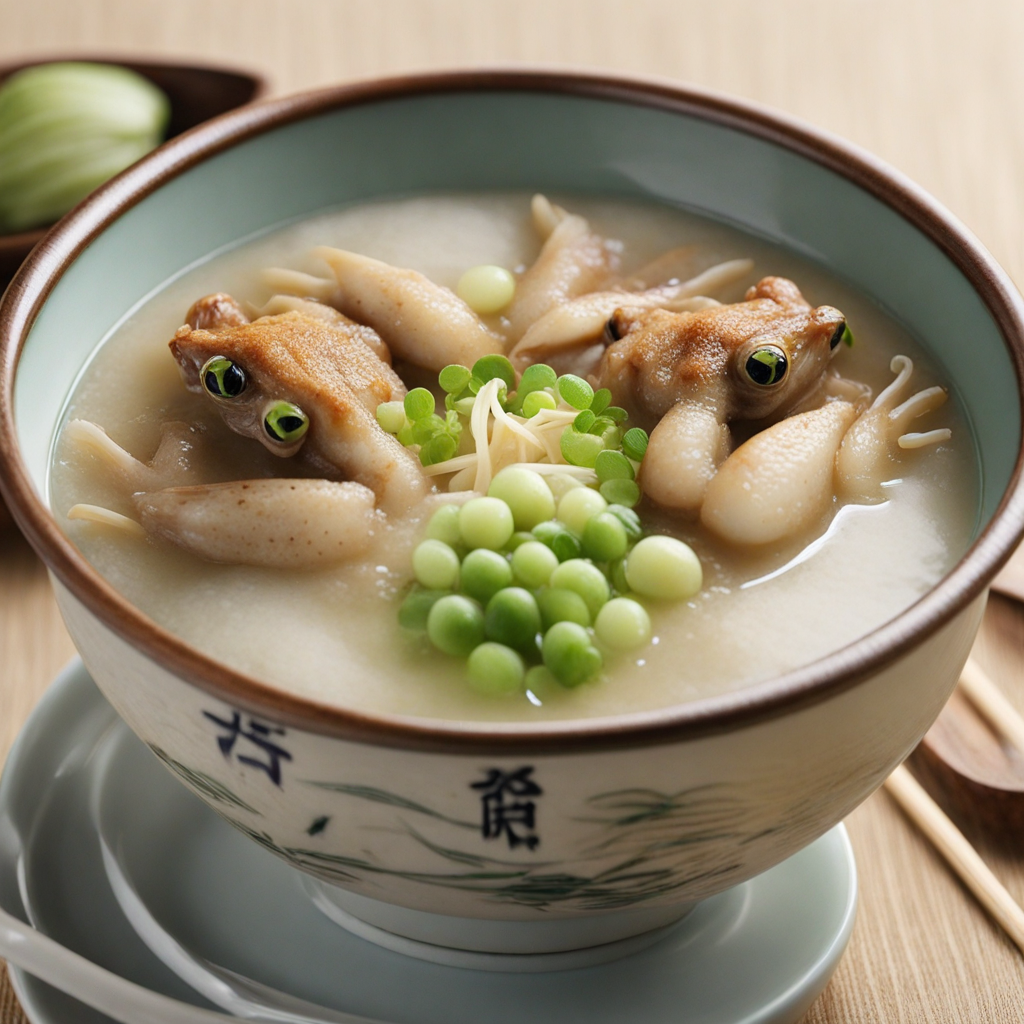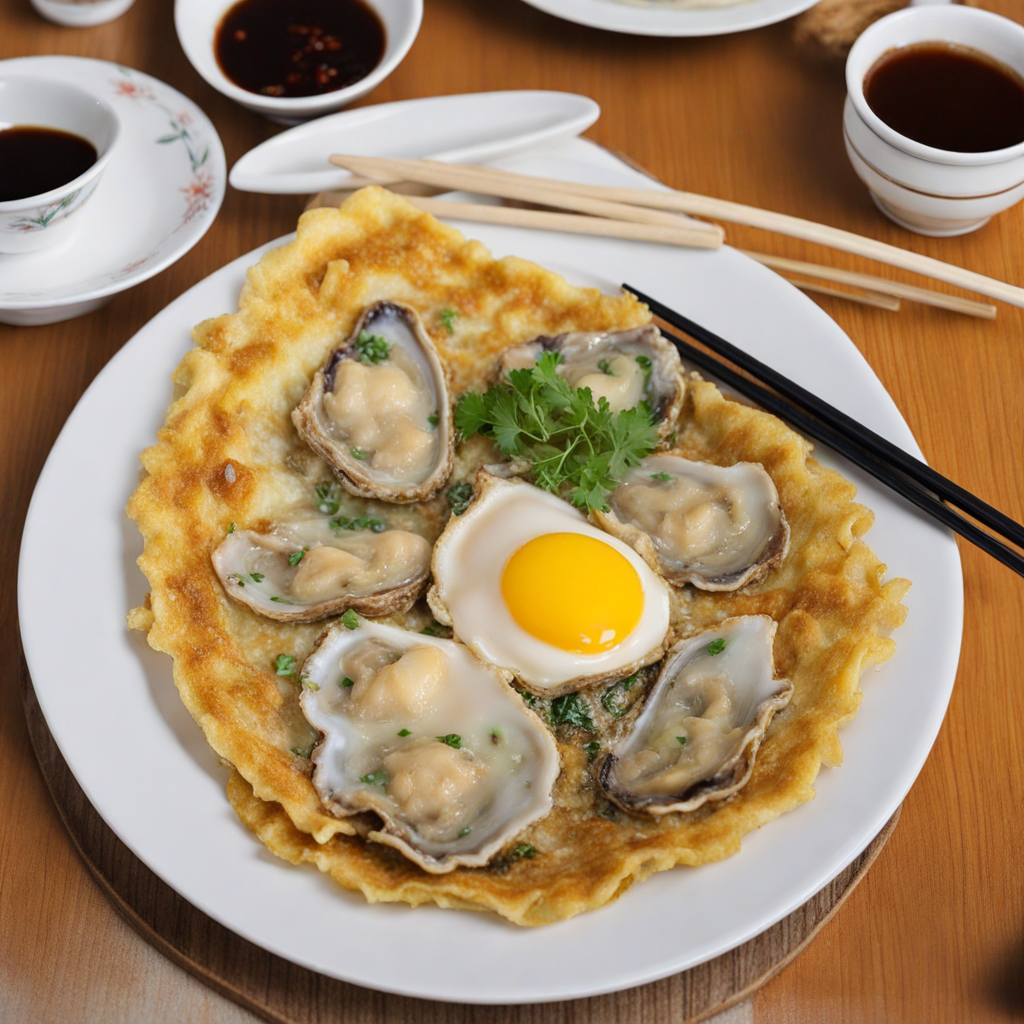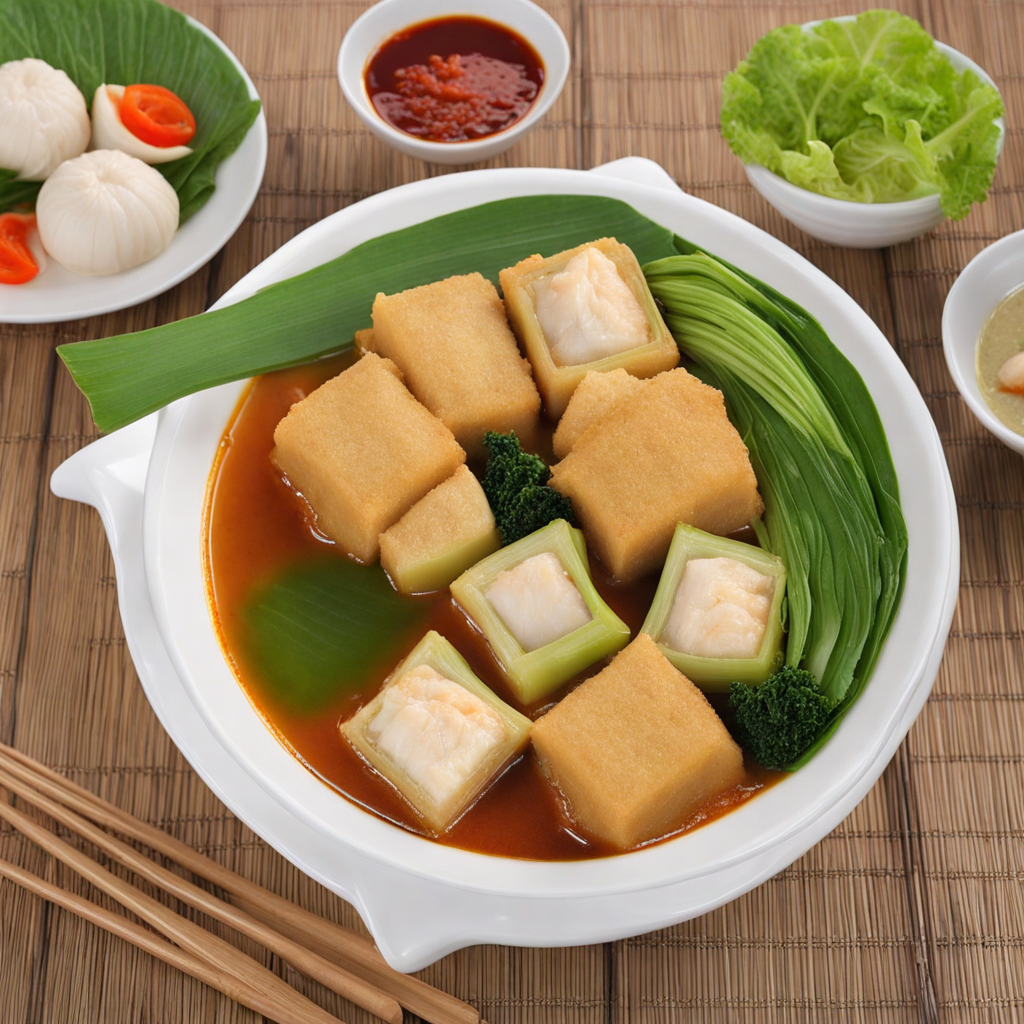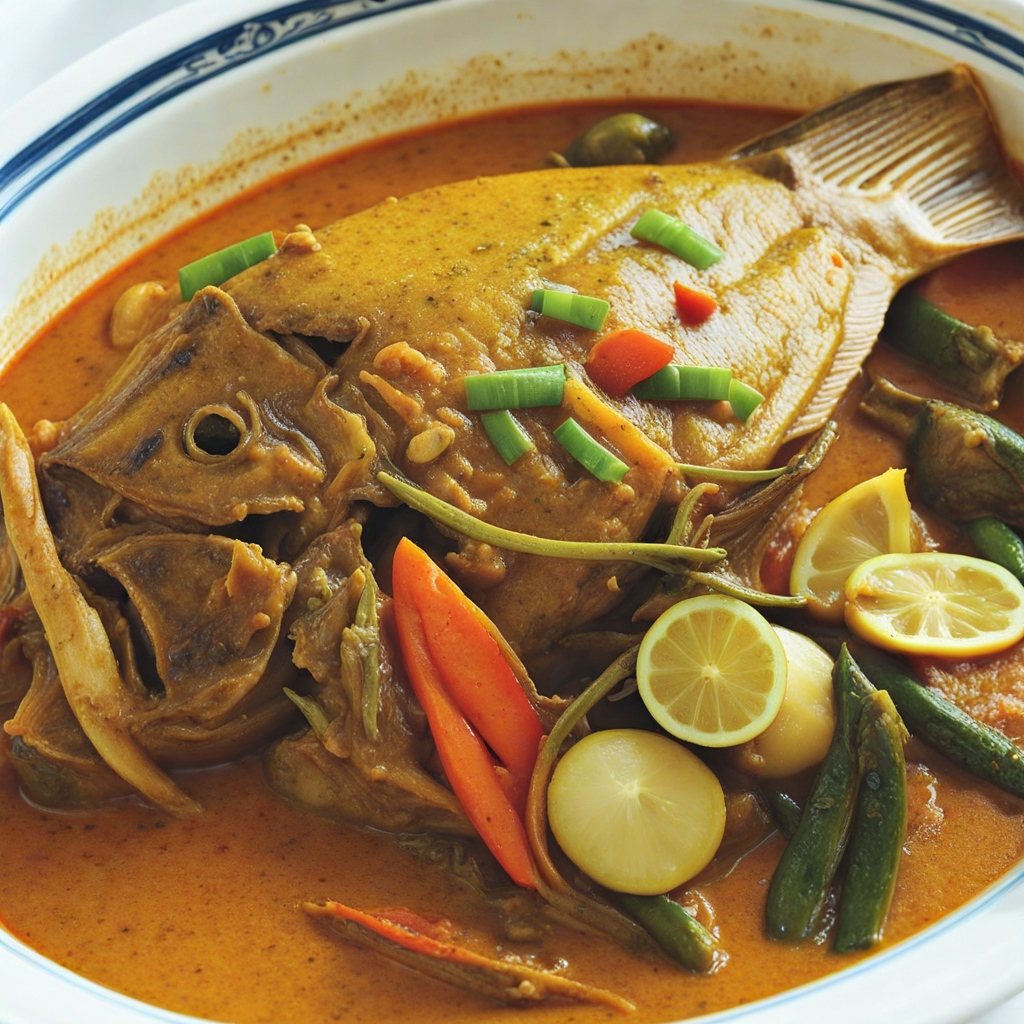Bak Kut Teh
Bak Kut Teh, a beloved dish originating from Singapore, is a hearty and aromatic pork rib soup that embodies the rich culinary heritage of the region. The name translates to "meat bone tea," referring to the tender, fall-off-the-bone pork ribs steeped in a flavorful broth. The dish is typically slow-cooked with a blend of herbs and spices, including star anise, garlic, and white pepper, which infuse the broth with a complex and savory flavor profile. The result is a warm, comforting soup that is both nourishing and invigorating, making it a popular choice for any time of the day, especially during rainy weather. Accompanying the succulent pork ribs are often a variety of side dishes that elevate the dining experience. Common accompaniments include fluffy steamed rice, crispy fried dough sticks (you tiao), and a selection of pickled vegetables, which add a delightful crunch and tang to balance the rich soup. Diners often customize their bowls with additional ingredients, such as mushrooms, tofu, or even mixed herbs, enhancing the dish's depth and personalizing it to suit individual tastes. The interplay of textures and flavors creates a satisfying meal that keeps you coming back for more. The experience of enjoying Bak Kut Teh goes beyond just the food; it's a cultural ritual that brings people together. In bustling hawker centers or cozy restaurants, the aroma of simmering broth wafts through the air, inviting diners to gather around steaming bowls. Whether enjoyed as a casual meal with friends or a family gathering, Bak Kut Teh represents comfort, warmth, and a celebration of Singapore's diverse culinary influences. For those seeking to explore new tastes, indulging in this dish offers a delightful journey into the heart of Singaporean cuisine.
How It Became This Dish
The Delectable History of Bak Kut Teh: A Culinary Treasure from Singapore Origins: A Fusion of Cultures Bak Kut Teh, which translates to "meat bone tea" in Hokkien, is a beloved dish that has become a culinary symbol of Singapore's multicultural heritage. Its roots can be traced back to the late 19th century when Chinese immigrants, particularly the Hokkien and Teochew communities, arrived in Singapore during the boom of the tin mining industry. The dish was initially created as a hearty meal to sustain laborers who worked long hours in the mines. The origins of Bak Kut Teh are intertwined with the local Chinese immigrant experience. The laborers sought a nutritious and economical meal to help them recover from the physical demands of their work. The dish typically consists of pork ribs simmered in a broth seasoned with a variety of spices, including star anise, cloves, cinnamon, and garlic. The broth is often infused with Chinese herbs, which were believed to have medicinal properties. This combination of flavors reflects the culinary traditions of the immigrants who adapted their cooking methods to include local ingredients available in Singapore. Cultural Significance: A Symbol of Community and Tradition Bak Kut Teh is more than just a dish; it is a cultural phenomenon that embodies community and tradition. Over the years, it has evolved from a simple meal for laborers to a cherished family dish enjoyed during gatherings and celebrations. The communal nature of eating Bak Kut Teh is significant; it is often served in large pots, encouraging diners to share the food and enjoy each other's company. In Singapore, Bak Kut Teh is not merely about the food; it is a social experience. It is common for families and friends to gather in Bak Kut Teh restaurants to enjoy the dish together. The ritual of ordering various cuts of meat, vegetables, and side dishes, along with the accompanying rice and Chinese tea, adds to the sense of community. This shared dining experience emphasizes the importance of relationships and togetherness in the fabric of Singaporean life. Development Over Time: From Street Food to Culinary Staple As Singaporean society transformed and modernized throughout the 20th century, so too did Bak Kut Teh. Initially served in humble street stalls, the dish gained popularity among locals and visitors alike. The post-war period saw an increase in the number of Bak Kut Teh establishments, many of which were family-run businesses passed down through generations. These restaurants became synonymous with tradition and authenticity, with each establishment boasting its own unique recipe and style of preparation. Two distinct styles of Bak Kut Teh emerged over time: the Hokkien version and the Teochew version. The Hokkien style is characterized by a dark soy sauce-based broth, which lends a rich, sweet flavor to the dish. In contrast, the Teochew style features a lighter, peppery broth with a more herbal taste. This divergence in preparation styles highlights the regional influences and preferences of the Chinese communities in Singapore. As Singapore evolved into a multicultural melting pot, Bak Kut Teh began to attract international attention. Tourists and food enthusiasts flocked to local eateries to savor the dish, and it gained a reputation as a must-try culinary experience. In response to this growing popularity, some restaurants began to innovate, introducing new ingredients and modern twists while still honoring traditional methods. Creative variations, such as herbal Bak Kut Teh, which incorporates a blend of medicinal herbs, and even vegetarian options, emerged to cater to diverse palates. Global Recognition: Singapore’s Culinary Ambassador In the 21st century, Bak Kut Teh has transcended its humble origins to become a culinary ambassador for Singapore. The dish is often featured in food festivals, culinary events, and international food competitions, showcasing the rich tapestry of Singaporean cuisine. It has also become a staple in Singapore’s hawker centers, where locals and tourists can enjoy authentic versions of the dish at affordable prices. The rise of social media and food blogging has further propelled Bak Kut Teh into the global spotlight. Food enthusiasts share their experiences and recommendations, leading to a surge in interest and appreciation for this local delicacy. In the age of globalization, Bak Kut Teh has become a symbol of Singapore’s culinary identity, representing the harmonious blend of cultures and flavors that define the nation. Culinary Craftsmanship: The Art of Preparation The preparation of Bak Kut Teh is an art form that reflects a deep understanding of flavors and cooking techniques. The dish typically begins with selecting high-quality pork ribs, which are simmered for hours to extract maximum flavor from the bones. The broth is carefully crafted, with a balance of spices and herbs that infuse the meat with their aromatic essence. Traditionally, Bak Kut Teh is served with a side of rice, fried dough (you tiao), and a selection of pickled vegetables. The combination of the tender meat, flavorful broth, and complementary sides creates a harmonious dining experience. The act of dipping the you tiao into the broth adds a delightful texture and flavor contrast, further enhancing the overall enjoyment of the dish. Conclusion: A Timeless Culinary Legacy As Bak Kut Teh continues to evolve, it remains a timeless symbol of Singapore's rich culinary heritage. Its journey from a laborer’s meal to a beloved national dish reflects the resilience and adaptability of the immigrant communities that shaped Singapore’s food culture. Today, Bak Kut Teh stands as a testament to the power of food to connect people, evoke memories, and celebrate traditions. In a world that often feels fragmented, the communal experience of sharing a bowl of Bak Kut Teh brings people together, bridging cultural gaps and fostering a sense of belonging. Whether enjoyed at a bustling hawker center or a cozy family gathering, Bak Kut Teh embodies the spirit of Singapore—diverse, vibrant, and undeniably delicious. As the dish continues to captivate hearts and palates, it will undoubtedly remain a cherished part of Singapore's culinary landscape for generations to come.
You may like
Discover local flavors from Singapore


